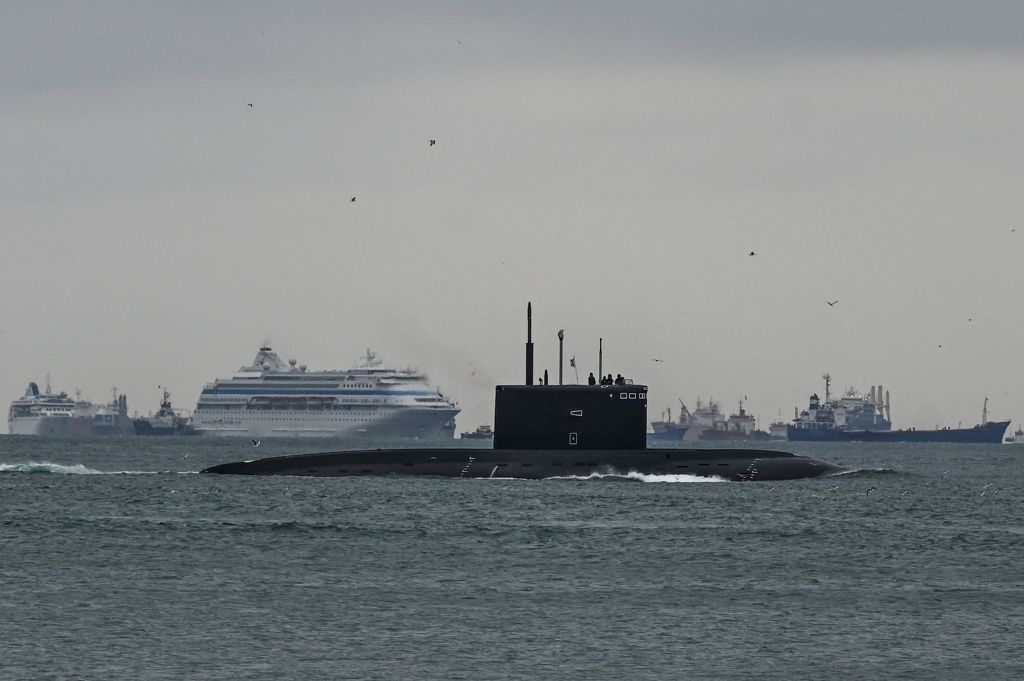Russian corvette is the latest target in Ukraine’s ongoing attacks on Russia’s Black Sea Fleet and military installations in Crimea. The video footage shows a drone successfully infiltrating the Russian corvette before the feed abruptly ends. This incident is just one example of Ukraine’s use of drones to target and damage Russian naval vessels in the Black Sea. Ukraine’s military claimed on August 3 that a missile strike had sunk a Russian Black Sea Fleet submarine and damaged an S-400 air defense system in Russian-occupied Crimea. The military named the Kilo-class submarine Rostov-on-Don as the submarine that sunk in the port of Sevastopol, stating that the boat sank immediately after being hit.
In addition to targeting Russian naval vessels, Ukraine has also been successful in damaging the S-400 Triumph air defense system, with four launchers being significantly damaged in the recent strike. The estimated value of the Kilo-class submarine is $300 million, according to Ukraine’s military, though these claims have not been independently verified. The Russian Defense Ministry has not yet responded to Ukraine’s claims regarding the reported strike. Prior to this incident, residents in Crimea reported hearing multiple blasts in various cities in the occupied peninsula, indicating ongoing conflict and attacks in the region. Despite these reports, Russia-installed proxy head of Sevastopol, Mikhail Razvozhayev, has made baseless claims about downed drones and U.S.-made missiles being found in the city. It remains to be seen how Russia will respond to Ukraine’s continued targeting of its Black Sea Fleet and military assets in Crimea.
These successful strikes by Ukraine have forced Moscow to relocate much of its naval forces from Crimea to the Russian port city of Novorossiysk. This strategic move highlights the impact of Ukraine’s drone attacks on Russia’s Black Sea Fleet, as it has shifted the balance of power in the region. By targeting Russian naval vessels and military installations, Ukraine has been able to inflict significant damage and disrupt Russia’s operations in the Black Sea. The loss or disablement of around 30% of Russia’s Black Sea Fleet due to Ukrainian strikes further emphasizes the effectiveness of Ukraine’s tactics in this ongoing conflict. With Russia being forced to consolidate its naval forces in Novorossiysk, Ukraine’s strategy of using drones to target and damage Russian assets has proven to be successful in weakening Russian naval capabilities in the Black Sea.
The continued conflict in Crimea, with Ukraine targeting Russian Black Sea Fleet vessels and military installations, highlights the ongoing tensions between the two countries. Since the full-scale invasion of Crimea by Russian troops in 2014, Ukraine has been engaged in a strategy of targeting Russian assets in the region to push back against the occupation. The recent strike on the Russian Black Sea Fleet submarine and S-400 air defense system is just the latest example of Ukraine’s efforts to disrupt Russian operations in Crimea. With successful strikes on Russian vessels and military installations, Ukraine is showing its ability to challenge Russian presence in the region and defend its territorial integrity.
As the conflict in Crimea continues, it is clear that Ukraine’s use of drones and missile strikes has been effective in targeting and damaging Russian assets. The sinking of the Russian Black Sea Fleet submarine and the damage to the S-400 air defense system are significant blows to Russia’s military capabilities in the region. By forcing Russia to relocate its naval forces to Novorossiysk, Ukraine has been able to weaken Russian presence in Crimea and disrupt its operations in the Black Sea. These actions demonstrate Ukraine’s determination to push back against Russian occupation and assert its sovereignty over the region. As the conflict evolves, it remains to be seen how Russia will respond to Ukraine’s continued attacks on its Black Sea Fleet and military targets in Crimea.
The use of drones in targeting Russian naval vessels and military installations represents a new phase in the conflict between Ukraine and Russia in Crimea. By effectively employing drones to carry out precision strikes on Russian assets, Ukraine has demonstrated its capacity to challenge Russian dominance in the region. The successful sinking of a Russian submarine and damaging of an S-400 air defense system showcases Ukraine’s ability to disrupt Russian operations and inflict significant damage on its military capabilities. As Ukraine continues to target Russian assets in Crimea, the conflict in the region shows no signs of abating, with both sides engaged in a ongoing struggle for control. The use of drones as a strategic weapon in this conflict underscores the evolving nature of modern warfare and the ways in which technology is shaping the outcomes of military engagements.


